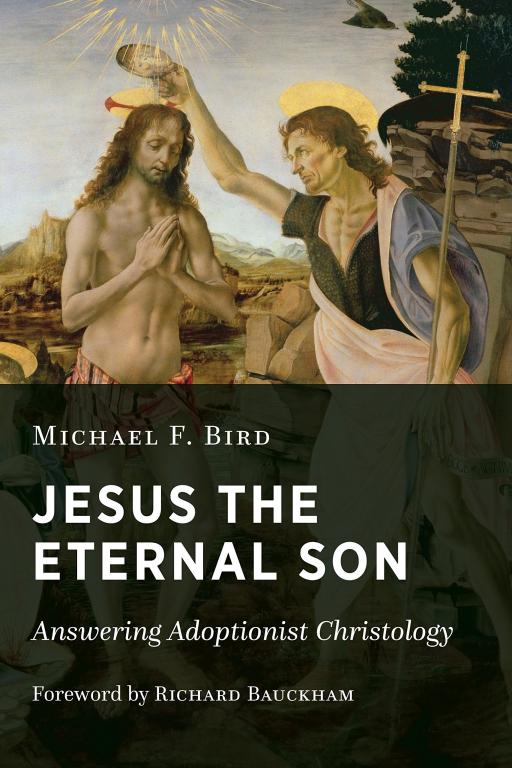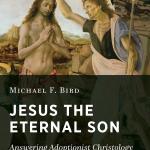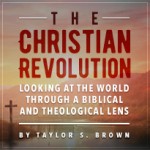Well, after about a two-week long hiatus due to my computer being in the shop for keyboard repairs, I am finally back to go over the second chapter of Michael Bird’s book Jesus the Eternal Son (Eerdmans, 2017).

In this chapter, Bird begins to dive into some of the key biblical texts that are often put forward in favor of adoptionist Christological readings. The passages he specifically tackles in this chapter are those that seem to point to adoption in the wake Christ’s resurrection: Rom. 1:3-4, and Acts 2:36, 5:31, and 13:33. And while it seems that on the surface these texts point to an adoptionist reading of Christ’s sonship, as Bird argues this is not the quite the case.
Bird starts with Rom 1:3-4. As a recap for readers, this verse is part of Paul’s opening greeting to the Roman Christians, wherein he is both building rapport and authority with a church he did not have a hand in founding (as opposed to the churches in Galatia and Corinth, among others). The text (along with vv. 1-2 for context) reads as follows:
¹From Paul, a slave of Christ Jesus, called to be an apostle, set apart for the gospel of God. 2 This gospel he promised beforehand through his prophets in the holy scriptures, 3 concerning his Son who was a descendant of David with reference to the flesh, 4 who was appointed the Son-of-God-in-power according to the Holy Spirit by the resurrection from the dead, Jesus Christ our Lord. (New English Translation)
The problem for a traditional incarnational reading is obvious here. Paul say that Jesus was “appointed Son of God in power according to the Holy Spirit by the resurrection from the dead.” This would seem to very clearly lead to the conclusion that Christ only became the Son of God after he was resurrected. Indeed, several scholars have argued over the year that this text was an early Christian adoptionist creed that Paul took and tried to adjust toward an incarnational reading. As Bird notes, however, there are several problems with such a thesis. First and foremost is that early Christian creedal formulations in the NT were not exhaustive in their construction. Rather, they were, “abbreviated confessions of faith, succinct to a point but ultimately insufficient, functioning as a symbols and signs of a wider body of beliefs” (p. 12). Such creedal formulations, while precursors to later confessions like those of Nicea and Chalcedon, were not themselves full-bore, exhaustive confessions. In the context of an oral-aural culture, where documents such as Romans would have been surrogates for the spoken word, these abbreviated creedal formulations would have served to signal hearers to a wider thought-world of belief.
The takeaway from all of this is that it is spurious to say that slightly differing creedal formulations in the NT represent various and opposing Christologies. As Bird notes:
They [the early creedal formulas] are not comprehensive in their affirmations and they make no denials. They are, in other words, the ancient equivalent of a doctrinal bumper sticker or the condensing of a complex theological topic into a single message. So we should not assume that these densely packed sentences were the totality of what people believed about Jesus, or that early Christians were disinterested or even opposed to anything else that might be said about Jesus. The early Christological formulas in the New Testament do not reflect the remnants of independent Christologies but rather signal efforts to articulate convictions shared among various Christian groups…In other words, no scholar can truly say with confidence: This is what they first believed, and this all that they believed! (pp. 12-13)
This of course means that we cannot look at a text like Rom. 1:3-4 and say definitively that it implies an early adoptionist Chrisology.
With methodological step out of the way, Bird moves on to addressing text itself. Bird first examines how, in both OT and Second Temple texts, both the designations “Son/Seed/Descendant of David,” and “Son of God” are both applied within Messianic contexts. In this context, divine sonship is already “embedded in the designation of Jesus as the Davidic descendant prior to his resurrection” (16). If this is the case, that means that appointing of Jesus to be Son of God “in power” (en dynamei) was most likely not a change in Jesus’s ontological status (e.g., from not-Son-of-God to Son of God) but rather a “enhancing” or “upgrading” of Jesus’s preexisting divine sonship (16)
Bird strengthens this assessment by arguing against the thesis that Paul inserted the “in power” (en dynamei) on both internal and external grounds. Internally, it would make little sense for Paul to use and add to what he knew to be an adoptionist formulation to support his incarnationalist Christology (18). Externally, there is no real textual evidence or evidence in the reception history of the text to support the idea that “in power” was a later Pauline addition. Rather, proponents of theory come with a presupposition that adoptionism was earliest Christology, and have to find a way to get around contrary evidence (19-23). While Bird’s arguments are much more detailed than I can do justice to here, his concluding point is quite clear: Rom. 1:3-4 and the God’s appointing of Jesus to be “Son of God in power” are almost certainly not adoptionist in nature. Instead, it refers to a transition from one mode of divine sonship to another. To quote Bird:
To sum up, according to Rom 1:3-4, the resurrection marks a transition from Jesus’s messianic mode and earthly abode of divine sonship, to a new display of divine sonship defined by a regal function exercised from his heavenly position as God’s vice-regent…To be even more concise about it, Jesus’s divine sonship is transposed rather than triggered by resurrection, as he transitions from a Davidic Son of God to the Son of God in power who reigns on the Father’s behalf and intercedes for his followers (23).
After addressing the adoptionist reading of Rom. 1:3-4, Bird moves on to examine the some of the key texts found in Acts that are often used to prop up adoptionist Christological readings: Acts 2:36, 5:31, and 13:33. For the sake of space I’m not going to repost each of the verses here; thanks to the internet, all you have to do if you’re reading this post is open up a new tab on your browser and go to Bible Gateway to read them (in your preferred translation even). The overall gist of the three passages is similar to the that found in Rom. 1:3-4, namely that that the language used by Luke seems to point toward some sort of post-resurrection appointing or making of Christ to divine sonship, rather than incarnational, preexistent divine sonship. And indeed, a good deal of what Bird addressed with Rom. 1:3-4 applies to these passages as well.
As with his treatment Romans, Bird first makes a larger contextual point about the whole of Luke-Acts. Luke consistently portrays Jesus as the divine Son of God from the moment of his birth in Luke 1:32-35 onward in his joint biographical-historical work. Thus, to read the supposed adoptionist passages in Acts apart from this overarching thematic element is already to ignore Luke’s own authorial intent (25-26).
Bird goes on to address a number of elements within the Acts passages that not only go against the adoptionist readings of the texts, but that, when read contextually and holistically, actually point to an incarnationalist understanding. To note just one example, the fact that Jesus has the authority to dispense the Holy Spirit in Acts 2:33 (just prior to 2:36) is implicit proof of his ontological (rather than merely adopted or honorific) divine status, as this is something only within the purview of Yahweh in the both OT and Second Temple texts (27).
More examples could be adduced, but the summation of it all is that the Acts passages, when read contextually and holistically (rather than in an atomized fashion) actually point toward an incarnational reading of the Jesus’s sonship. As Bird notes:
This is not about the adoption of a human figure, but the enthronement of a divine agent with a very definite pre-history in his earthly life, and even pre-existence…Jesus is more properly known and recognized as Lord and Messiah upon his resurrection rather than transformed into a divine figure by means of resurrection. While a new status and new role is conferred, Jesus’s identity, personhood, and being remain consistent upon the resurrection and heavenly ascent. According to Kavin Rowe¹, the shift to which Acts 2:36 [and by logical extension 5:31 and 13:33] points is not ontological but epistemological (28-29).
¹C. Kavin Rowe, Early Narrative Christology: The Lord in the Gospel of Luke (Grand Rapids: Baker, 2009), 194. Emphasis in original.
So there you have it readers. Bird has started out his book by addressing a few of the most noteworthy biblical texts used to support the claim that adoptionism was the earliest extant Christology. While my summaries do not do justice to depth of Bird’s analysis and arguments (and so you should really go buy the book and read it for yourself), I find his arguments quite persuasive. In the next post in this series we will move into chapter 3 of the book: “The Gospel of Mark, Monotheism, and Deification.” And hopefully I will get it out a lot sooner than two weeks from now, especially now that my computer is finally fixed! Until then, go buy Bird’s book and begin reading it for yourself!
Soli Deo Honor et Gloria











